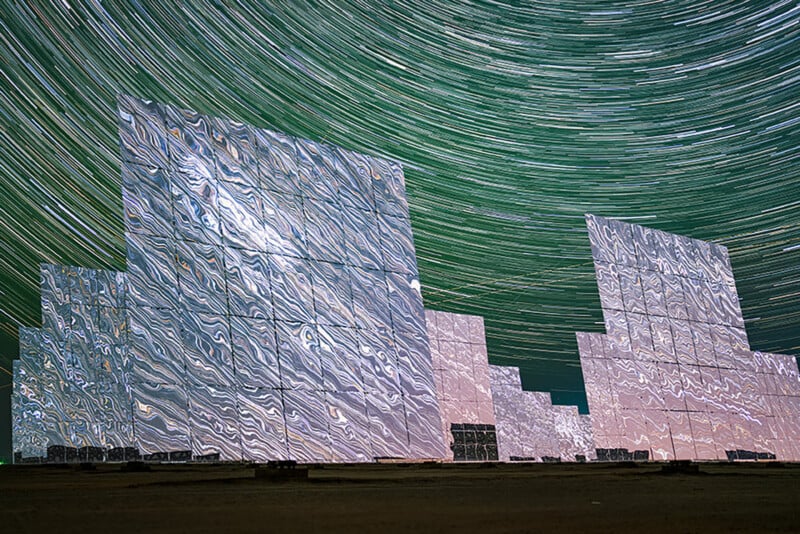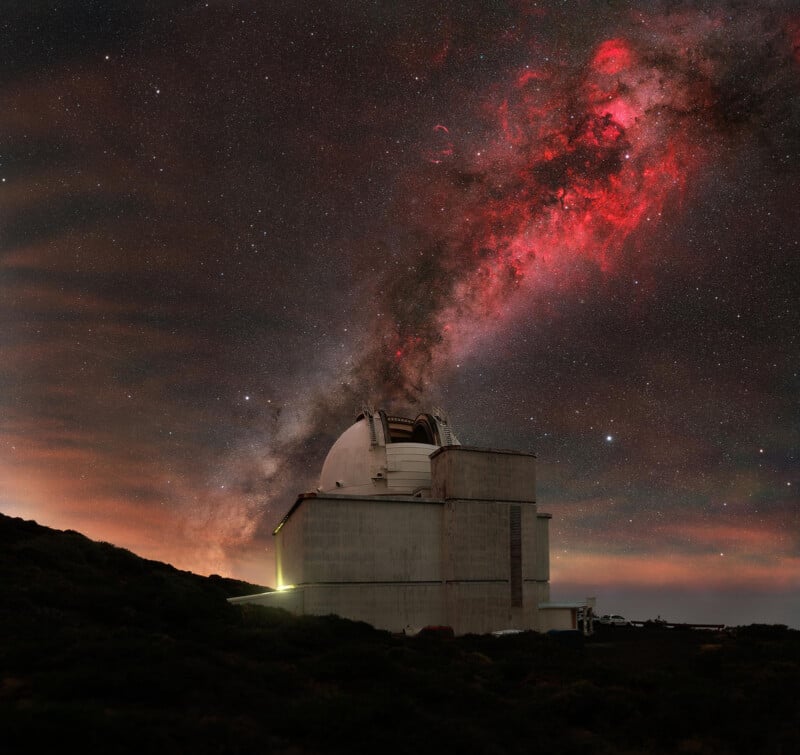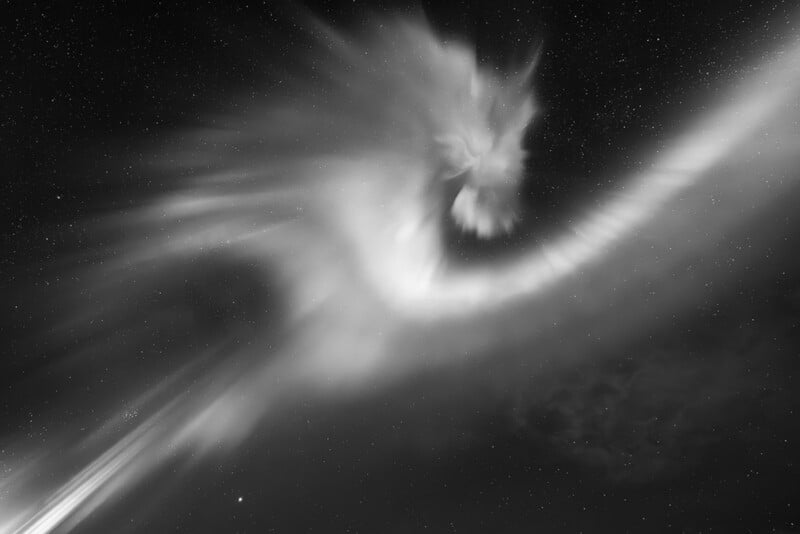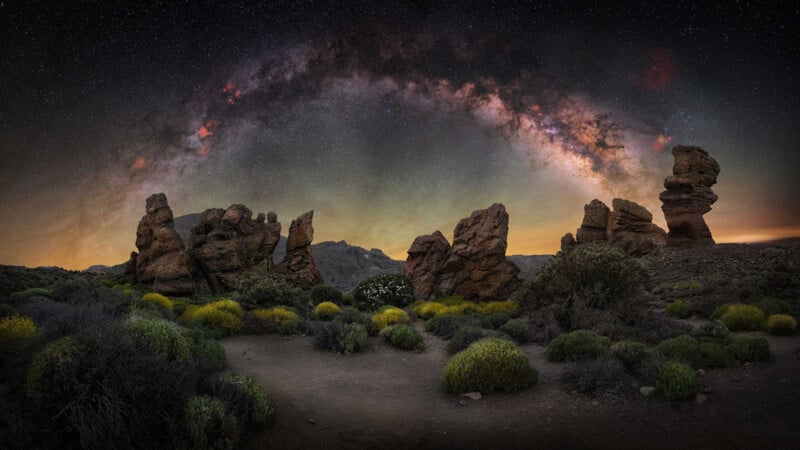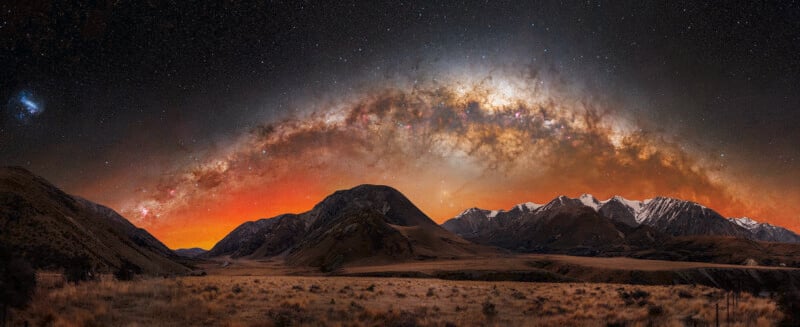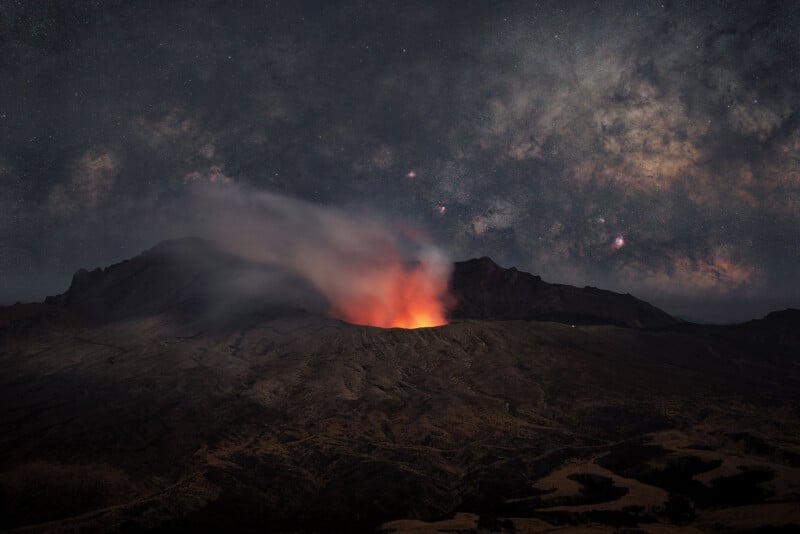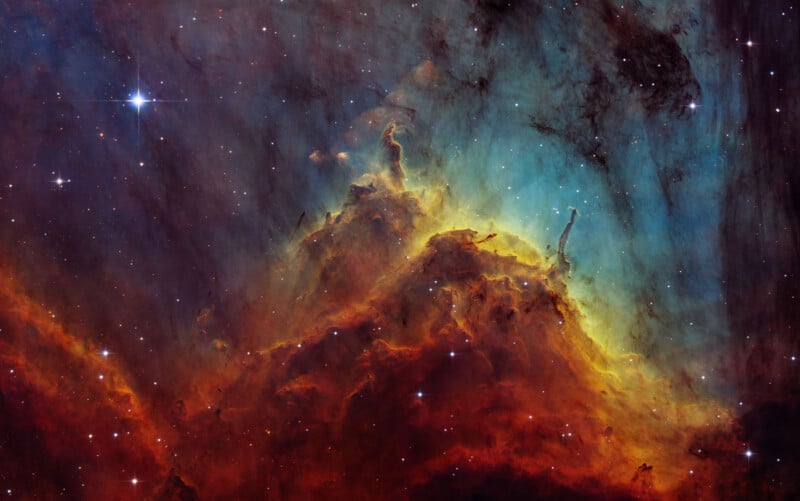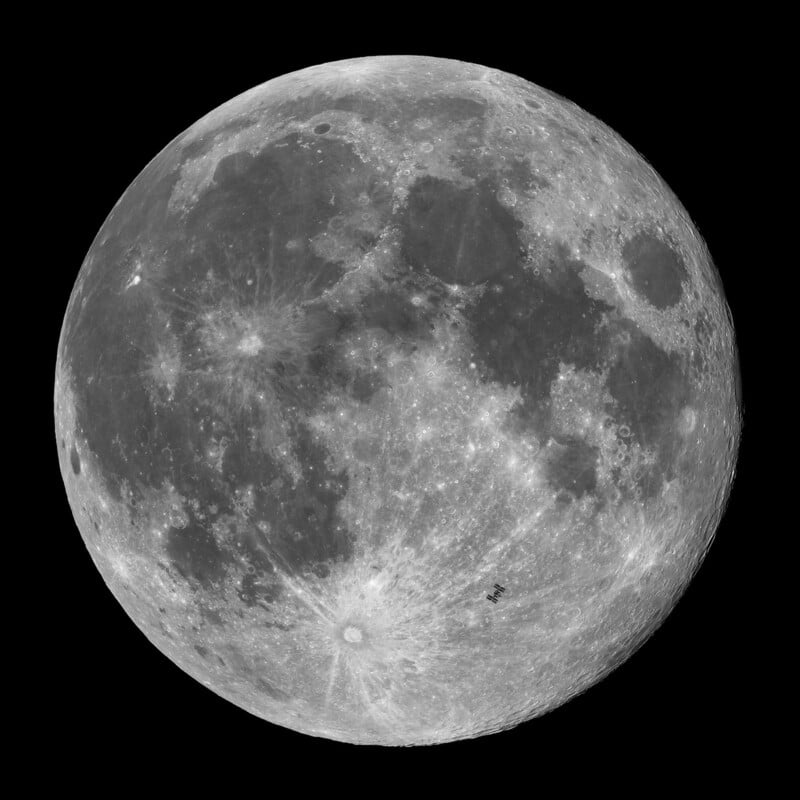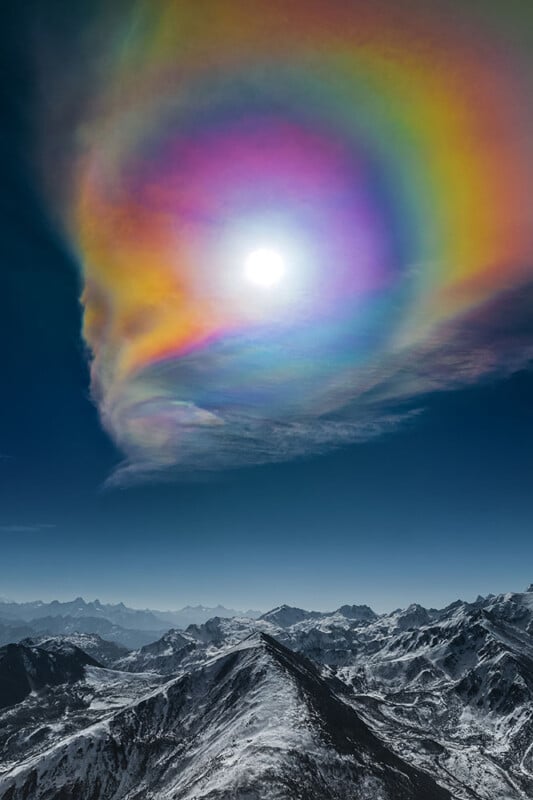The shortlist for the Astronomy Photographer of the Year has been revealed with a hatful of spectacular celestial images picked from over 3,500 entries.
Astrophotographers from 58 countries across the world entered the competition with the shortlist containing remarkable highlights such as aurora lights in the shape of a dragon.
The competition is organized by Royal Observatory Greenwich, supported by Liberty Specialty Markets and in association with BBC Sky at Night Magazine .
People and Space
Abandoned House © Stefan Liebermann (Germany). | This image shows an abandoned house in the middle of the Namib Desert with the Milky Way rising above it. The sky was captured with a star tracker to lower the ISO. The veil of clouds and halos around the stars create a dreamlike effect. | Taken with a Sony ILCE-7RM5 camera, 24 mm f/1.6, Sky: ISO 1,000, 120-second exposure; Foreground: ISO 800, 270-second exposure. | Location: Garub, Namibia, 22 April 2023. Cosmos in Reflection © Jianfeng Dai (China). | The 100-megawatt molten salt tower photovoltaic power station pictured here has 12,000 super mirrors. In the daytime, the mirror matrix reflects the sunlight back to the central heat-collection tower which can reduce carbon dioxide emissions by 350,000 metric tonnes per year. At night, the mirrors reflect the light of nebulae, clusters, planets, the Milky Way, and countless stars at different angles, making it difficult to tell what’s real and what’s not. | Taken with a Sony ILCE-7RM5 camera, Sony FE 50 mm F1.2 GM lens, 50 mm f/1.2, ISO 3,200, 5-second exposure. | Location: Dunhuang, Gansu Province, China, 15 September 2023. Observations at Night © Jakob Sahner (Germany). | This image captures the Isaac Newton Telescope at the edge of the telescope facility on La Palma, in the Canary Islands. Moving the focus away from the center of the Milky Way, Sahner explores other interesting areas of the galaxy such as the Cygnus region, seen in the top right of the image with its bright and vibrant star-forming regions. This photograph is a panorama created with a 135-mm lens which brings extreme depth to the shot. | Taken with a Sony ILCE-7s and ILCE-7iii camera, Sky-Watcher Star Adventurer mount, Samyang 135 mm f/2 lens, Sky: 73 panels of 4 x 60-second RGB exposures (ISO 2,000), 16 panels of 4 x 60-second H-alpha exposures (ISO 6,400); Foreground: 36 panels of 30-second exposures (ISO 2,000). | Location: Roque de los Muchachos, La Palma, Canary Islands, Spain, 13 December 2023. Run to Carina © Vikas Chander (India). | This photograph captures a sculpture in north-west Namibia. Made of stone, this is one of a group of sculptures known as the ‘Lone Men of Kaokoland’ [as the region was formerly known]. No one knows who has put them there. A long exposure of the stone running man was taken first, then the tripod was moved for a clear view of the horizon. | Taken with a Sony Alpha 7R V camera, 35 mm f/2.8, ISO 800, 480-second exposures. | Location: Kunene Region, Namibia, 15 September 2023. Planets, Comets, and Asteroids
The Dance of Jupiter’s Moons © Marco Lorenzi (Italy). | This image shows the planet Jupiter surrounded by its moons Io and Ganymede. The use of a large aperture reveals several details on both the planet and the surfaces of the moons. This image is the result of stacking the best frames from six 60-minute videos taken in RGB (two videos per color). | Taken with a Nauris Vates 21″ telescope, home-made horseshoe mount, Player One Saturn-M SQR (IMX533M) camera, 21″ (535 mm) f/3.8 with Barlow 5x (at f/19), multiple 4-millisecond exposures. | Location: Singapore, 18 November 2023 Saturn with Six Moons © Andy Casely (Australia). | Saturn’s decreasing ring tilt means the moon Titan is closer to Saturn from our viewpoint than it has been in over a decade. At the center of the image, Tethys is just about to disappear behind Saturn, while Rhea, Enceladus, and Mimas are on the left, and Dione is to the lower right. The planet’s shadow on the rings is prominent, as are the Cassini and Encke divisions. | Taken with a Celestron C14 Schmidt-Cassegrain telescope, Tele Vue 2x Barlow lens, Chroma RGB filters, Celestron CGX-L mount, QHY5III200M camera, 10,000 mm f/29, 40-minute video, 10-millisecond exposures, 25% of ~220,000 total frames. | Location: Blue Mountains, New South Wales, Australia, 24 September 2023. M100 (The Blowdryer Galaxy) and Ceres © Damon Mitchell Scotting (UK). | In this image the photographer was able to capture a dwarf planet, Ceres, more than a billion times smaller than its galactic counterpart, transit beyond the galaxy’s spiraling arms. Ceres shines brighter than the galaxy and moves quickly across the night sky. For this image, multiple long exposures were captured over an eight-hour period to showcase the beauty of the Blowdryer Galaxy and the relatively quick speed of the dwarf planet Ceres. | Taken with a PlaneWave CDK24 telescope, Mathis Instruments MI-1000/1250 mount, QHY600M camera, 72 x 5-minute and 120 x 3-minute luminance, 22 x 5-minute red, 20 x 5-minute green and 32 x 5-minute blue exposures, 18 hours 10 minutes total exposure. | Location: El Sauce Observatory, Río Hurtado, Chile, 22, 27 and 31 March 2023, 12 January and 2 March 2024. Aurorae
A Night with the Valkyries © Jose Miguel Picon Chimelis (Spain). | A view of the Eystrahorn Mountain on the night of a KP7 storm (a strong geomagnetic storm that can cause aurorae and upset electrical power systems). The intensity of the storm resulted in the impressive range of colors in the sky. | Taken with a Nikon Z7 II camera, 14 mm f/1.8, ISO 6,400, 4-second exposure. | Location: Hvalnesviti, Iceland, 2 December 2023 Arctic Dragon © Carina Letelier Baeza (Chile) | This impressive aurora, which seemingly takes the form of a dragon, was the result of a geomagnetic storm (level G2) generated by a coronal mass ejection. The photo was captured at the Arctic Henge, which was one of the only places in Iceland with clear skies that night. | Taken with a Nikon D810A camera, 14 mm f/1.8, ISO 6,400, 2.5-second exposure. | Location: Raufarhöfn, Iceland, 25 February 2023 The Fire-Spitting Dragon © Moritz Telser (Italy). | The photographer was able to capture the aurora in motion when it turned into something resembling a dragon’s head on a clear night. Telser chose to use black and white to emphasize the contrast of the aurora against the dark sky. | Taken with a Canon EOS R6 camera, 14 mm f/2.8, ISO 12,800, 1.6-second exposure. | Location: Uttakleiv Beach, Lofoten, Norway, 13 October 2023 Skyscapes
A Cosmic Firework: the Geminid Meteor Shower © Jakob Sahner (Germany). | This photograph of the Geminid meteor shower was taken under perfect conditions on La Palma. During the peak of the night, Sahner could easily spot two or three or more meteors per minute within the field of view. The panorama shows the entire winter Milky Way as seen from La Palma in RGB natural colour with extra details in H-alpha. | Taken with a Sony ILCE-7M3 camera, Sigma 28 mm f/1.4 lens, Sky-Watcher Star Adventurer mount, 28 mm f/1.4, Sky: 14 panels of 60-second RGB exposures (ISO 1,600), 5 panels of 3 x 180-second H-alpha exposures (ISO 6,400); Foreground: 16 panels of 60-second exposures (ISO 1,600). | Location: Roque de los Muchachos, La Palma, Canary Islands, Spain, 11 and 15 December 2023. Ancestral Rocks © Andrea Curzi (Italy). | This image shows the Milky Way and the Roques de García, a group of rock formations located inside the Las Cañadas caldera in the Teide National Park. The image is a panorama of two files, one for the foreground and one for the sky. | Taken with a Canon EOS R and EOS 6D cameras, 25 mm f/4, Sky: ISO 800, 120-second exposure; Foreground: ISO 3,200, 120-second exposure. | Location: Tenerife, Canary Islands, Spain, 18 May 2023. Auroral Touch: the Milky Way’s Close Encounter © Chester Hall-Fernandez (New Zealand). | This image was taken in Castle Hill, New Zealand, facing south as the Milky Way set. Partway through the night, Hall-Fernandez noticed a faint glow growing stronger, though he was not expecting to see the Aurora Australis. As the aurora was very far away, only the deep reds were visible. | Taken with a Nikon Z 6 (astro-modified) camera, Tamron 35 mm f/1.4 lens, ISO 1,600, Sky: 11 x 60-second tracked exposures; Foreground: 6 x 60-second exposures. | Location: Castle Hill, New Zealand, 11 October 2023. Earth and Milky Way Galaxy Show © Yoshiki Abe (Japan). | Mount Aso in Kumamoto Prefecture is the collective name for the five peaks often called the ‘Five Mountains of Aso’. One of the peaks, Nakadake, has a volcanic crater that is still active. Abe wanted this image to show how the Milky Way has watched over activity on Earth since prehistoric times. This is a composite photograph with the foreground and sky photographed separately but without moving the tripod. | Taken with a Sony ILCE-7RM5 camera, 50 mm f/4, Sky: ISO 5,000, 60-second exposure (stack of 10 frames); Foreground: ISO 800, 30-second exposure (stack of 9 frames). | Location: Aso City, Kumamoto Prefecture, Japan, 18 February 2024. Serpentine © Paul Haworth (UK). | This image was taken at Snettisham Beach, famous for its vast tidal mudflats that attract migrating birds in staggering numbers. The foreground subject is a dilapidated jetty, which was built in the Second World War to allow gravel extracted from the nearby pits to be moved by boat. The curved channel in the mudflat mirrors the trailing stars. | Taken with a Canon 6D camera, Samyang 14 mm f/2.8 lens, ISO 400, 319 x 30-second exposures Foreground: ISO 800, 120-second exposure. | Location: Snettisham Beach, King’s Lynn, Norfolk, UK, 19 and 20 April 2023. Stars and Nebulae
GUM 12: the Gum Nebula (Vela Supernova Remnant) © Charles Pevsner (USA). | This is a small portion of the Vela supernova, which exploded about 11,000 years ago. Its remnants sprawl across eight degrees of the night sky (about 16 times the width of the Full Moon), but are extremely dim, requiring very long exposure times. | Taken with a Takahashi TOA-130 telescope, Astrodon Gen2 HSO filters, 10Micron GM000 HPS mount, ZWO ASI6200MM camera, 1,000 mm f/7.7, 9 hours 42 minutes total exposure. | Location: El Sauce Observatory, Rio Hurtado, Chile, 25 February, 18 and 22 March 2023. Misty Mountains © Bence Tóth (Hungary). | This image is a close look at IC 5070, the Pelican Nebula. The fine dust and gas structures are reminiscent of mist on mountains hit by the rising Sun, hence the title. In the picture some HH objects [Herbig-Haro objects are bright regions or nebulosity around newborn stars] are also clearly visible, somewith distinct structural details (HH-563, HH-564, HH-565 and HH-555). | Taken with a custom-built 250/1000 Newton astrograph telescope, Antlia 3 nm H-alpha, OIII and SII bandpass filters, Sky-Watcher EQ8-R Pro mount, ZWO ASI2600MM Pro camera, 1,000 mm f/4, 57 x 600-second H-alpha exposures, 30 x 600-second OIII exposures, 77 x 600-second SII exposures. | Location: Szödliget, Pest, Hungary, 10–14 August 2023. The Scream of a Dying Star © Yann Sainty (France). | The Cygnus supernova afterglow is a popular object with astrophotographers, but the idea here was to take advantage of the high quality of the sky and the long exposure time to highlight details that are rarely seen, such as the outer envelope of the supernova remnant. The image’s name is a nod to The Scream, the famous painting by Edvard Munch, symbolising the scream that continues to echo through space after the star’s death. | Taken with a Takahashi FSQ106EDX4 telescope, Sky-Watcher EQ6-R Pro mount, ZWO 2600MM camera, 382 mm f/3.6, 48 hours total exposure with 60 and 300-second subframes. | Location: Oukaïmeden, Atlas Mountains, Morocco, 1–3, 5 and 24–26 July 2023. Galaxies
A Milky Way Mimic © Kevin Morefield (USA). | NGC 6744 is thought to resemble our own Milky Way as it would be seen from 30 million light years away. The colours of this galaxy are those of the classic spirals: magentas of the emission nebulae, blues of the large young stars, yellows of the older stars and yellow-browns from the dust spiralling into the core. From Earth, NGC 6744 appears about two-thirds the size of the Full Moon. | Taken with a PlaneWave CDK17 telescope, Chroma filters, PlaneWave L-600 mount, ATIK APX60 camera, 2,939 mm f/6.8, 29.25 hours total exposure. | Location: El Sauce Observatory, Río Hurtado, Chile, 11, 28 and 30 May, 1, 4, 5, 8 and 29 June, 14–16 and 24 July, 4 August, 3, 5, 6, 12–17, 20 and 21 September 2023. The Galaxy Devourer © ShaRa. | CG4 (Cometary Globule 4) is a complex of nebulosity and dust with a very peculiar shape, located in the southern constellation of Puppis. The ‘head’ of the galactic worm has dimensions of about 1.5 light years. | This image is the result of the work of a team of astrophotographers: they joined forces to rent the powerful Newtonian 500-mm telescope from Chilescope service, processing the raw files and then voted for the best images. | Taken with ASA RC1000 and Newton 500 telescopes , Astrodon HLRGB filters, ALT AZ mount, FLI16803 camera, 6,800 mm f/6.8, Gain 0, multiple 180 and 600-second exposures. | Location: El Sauce Observatory, Río Hurtado, Chile, 14–15 March 2023. The Inner Dust Lanes of M104 (The Sombrero Galaxy) © Kevin Morefield (USA). | The intense brightness of M104’s core often hides the details that lie inside the encircling ring of dust. In this image the dust appears to spiral into that core, floating on a wafer-thin layer as it falls towards the massive central black hole. The brighter, more colourful stars in the image are actually in the foreground − a part of our Milky Way galaxy. | Taken with a PlaneWave CDK17 telescope, Chroma LRBG filters, PlaneWave L-600 mount, ATIK APX60 camera, 2,939 mm f/6.8, 29.25 hours total exposure. | Location: El Sauce Observatory, Río Hurtado, Chile, 15–26 March 2023. Our Moon
Hunter’s Moon and the ISS © Tom Glenn (USA). | This image captures the International Space Station (ISS) in transit across October’s Full Moon, the Hunter’s Moon, approximately 12 hours after a partial lunar eclipse. The striking beauty of the Full Moon is on display, with its mix of rugged highlands, bright crater rays and darker maria. | Taken with a TPO 6” Newtonian telescope, Celestron CGEM mount, ZWO ASI183MM camera, 916 mm f/6, 0.3-millisecond, single frame exposure. | Location: San Diego, California, USA, 29 October 2023 The International Space Station Daytime Moon Transit © Kelvin Hennessy (Australia). | This image shows the International Space Station (ISS) transiting the 51 per cent illuminated Moon. The photographer initially struggled to find a suitable shooting location with clear skies along the very narrow transit corridor. | Taken with a Saxon ED127 FCD100 Triplet Refractor telescope, Baader IR/UV filter, Sky-Watcher EQ6-R mount, ZWO 294MC Pro camera, 952 mm f/7.5, Gain 192, 1-millisecond exposure. | Location: Gold Coast, Queensland, Australia, 3 February 2024. Our Sun
A Whale Sailing the Sun © Eduardo Schaberger Poupeau (Argentina). | This image shows the details of the Sun’s surface. The photographer views the shape of the filament to the left of the disc as an immense plasma whale traversing the solar surface. Eduardo Schaberger Poupeau captured this photo by recording two videos (one for the disc and another for the prominences), each consisting of 850 frames. | Taken with a Coronado SolarMax III Double Stack 60 mm telescope, iOptron CEM 70 mount, QHYCCD QHY5III678M camera, 400 mm f/6.6, Disc: 1.43-millisecond exposure, Prominences: 10.98-millisecond exposure. | Location: Rafaela, Santa Fe, Argentina, 23 December 2023. Solar Pulsation © Wenlian Li (China). | This image captures a sunspot erupting at the edge of the Sun where material is ejected from an active volcano. Dual filters were used to improve contrast and the stereoscopic effect. | Taken with a Sky-Watcher Achromat 120 refractor telescope, Daystar Quark Chromosphere filter, Sky-Watcher EQ3D mount, QHYCCD QHY5III174M camera, 5,040 mm f/42, 12mm exposure. | Location: Baqiao District, Xi’an, Shaanxi Province, China, 18 July 2023 The Palette of the Himalayas © Geshuang Chen (China). | During the Spring Festival, the Sun and altostratus clouds acted together to create this huge corona, soaring above the Himalayas. The result is an enormous colour palette above the snowy peaks. | Drone footage, DJI Mavic 3 Camera, 12.3 mm f/5, ISO 100, 1/3200-second exposure. | Location: Shigatse City, Xizang Province, China, 24 January 2023. Total Solar Eclipse © Gwenaël Blanck (France). | Gwenaël Blanck travelled to Australia in April 2023 to see the 62-second long total solar eclipse. In this collage he shows the corona and the pink chromosphere, the prominences and Baily’s beads, chinks of sunlight that shine through due to the Moon’s rugged landscape. The image is made of seven superimposed pictures, one overexposed for the background and six others for the chromosphere and prominences. | Taken with a Nikon Z 50 camera, Sky-Watcher Star Adventurer mount, Sigma 100-400 f5-6.3 Contemporary lens, 400 mm f/8, ISO 100, prominences: 1 x 4,000-second exposure, corona: 1/15-second exposure. | Location: Exmouth, Western Australia, Australia, 20 April 2023. The Annie Maunder Prize for Image Innovation
Martian Dementors © Leonardo Di Maggio (UK). | This image is taken from the Mars Reconnaissance Orbiter (MRO) missions. By abstracting the image, the perspective is shifted and the Martian landscape transforms into something dark and atmospheric. Leonardo Di Maggio cropped the image to give the impression of legs of living creatures, while keeping the overall dark feeling of the photograph. | Original image data from the MRO HiRISE camera, IRB, RGB, from 27 July 2009. The competition is in its sixteenth year and an expert panel of judges will decide the winners of each category, two special prizes, and the overall winner which will be announced on September 12.
Reference
Dr. Thomas Hughes is a UK-based scientist and science communicator who makes complex topics accessible to readers. His articles explore breakthroughs in various scientific disciplines, from space exploration to cutting-edge research.
Denial of responsibility! Elite News is an automatic aggregator of Global media. In each content, the hyperlink to the primary source is specified. All trademarks belong to their rightful owners, and all materials to their authors. For any complaint, please reach us at – [email protected]
The shortlist for the Astronomy Photographer of the Year has been revealed with a hatful of spectacular celestial images picked from over 3,500 entries.
Astrophotographers from 58 countries across the world entered the competition with the shortlist containing remarkable highlights such as aurora lights in the shape of a dragon.
The competition is organized by Royal Observatory Greenwich, supported by Liberty Specialty Markets and in association with BBC Sky at Night Magazine .
People and Space
Abandoned House © Stefan Liebermann (Germany). | This image shows an abandoned house in the middle of the Namib Desert with the Milky Way rising above it. The sky was captured with a star tracker to lower the ISO. The veil of clouds and halos around the stars create a dreamlike effect. | Taken with a Sony ILCE-7RM5 camera, 24 mm f/1.6, Sky: ISO 1,000, 120-second exposure; Foreground: ISO 800, 270-second exposure. | Location: Garub, Namibia, 22 April 2023. Cosmos in Reflection © Jianfeng Dai (China). | The 100-megawatt molten salt tower photovoltaic power station pictured here has 12,000 super mirrors. In the daytime, the mirror matrix reflects the sunlight back to the central heat-collection tower which can reduce carbon dioxide emissions by 350,000 metric tonnes per year. At night, the mirrors reflect the light of nebulae, clusters, planets, the Milky Way, and countless stars at different angles, making it difficult to tell what’s real and what’s not. | Taken with a Sony ILCE-7RM5 camera, Sony FE 50 mm F1.2 GM lens, 50 mm f/1.2, ISO 3,200, 5-second exposure. | Location: Dunhuang, Gansu Province, China, 15 September 2023. Observations at Night © Jakob Sahner (Germany). | This image captures the Isaac Newton Telescope at the edge of the telescope facility on La Palma, in the Canary Islands. Moving the focus away from the center of the Milky Way, Sahner explores other interesting areas of the galaxy such as the Cygnus region, seen in the top right of the image with its bright and vibrant star-forming regions. This photograph is a panorama created with a 135-mm lens which brings extreme depth to the shot. | Taken with a Sony ILCE-7s and ILCE-7iii camera, Sky-Watcher Star Adventurer mount, Samyang 135 mm f/2 lens, Sky: 73 panels of 4 x 60-second RGB exposures (ISO 2,000), 16 panels of 4 x 60-second H-alpha exposures (ISO 6,400); Foreground: 36 panels of 30-second exposures (ISO 2,000). | Location: Roque de los Muchachos, La Palma, Canary Islands, Spain, 13 December 2023. Run to Carina © Vikas Chander (India). | This photograph captures a sculpture in north-west Namibia. Made of stone, this is one of a group of sculptures known as the ‘Lone Men of Kaokoland’ [as the region was formerly known]. No one knows who has put them there. A long exposure of the stone running man was taken first, then the tripod was moved for a clear view of the horizon. | Taken with a Sony Alpha 7R V camera, 35 mm f/2.8, ISO 800, 480-second exposures. | Location: Kunene Region, Namibia, 15 September 2023. Planets, Comets, and Asteroids
The Dance of Jupiter’s Moons © Marco Lorenzi (Italy). | This image shows the planet Jupiter surrounded by its moons Io and Ganymede. The use of a large aperture reveals several details on both the planet and the surfaces of the moons. This image is the result of stacking the best frames from six 60-minute videos taken in RGB (two videos per color). | Taken with a Nauris Vates 21″ telescope, home-made horseshoe mount, Player One Saturn-M SQR (IMX533M) camera, 21″ (535 mm) f/3.8 with Barlow 5x (at f/19), multiple 4-millisecond exposures. | Location: Singapore, 18 November 2023 Saturn with Six Moons © Andy Casely (Australia). | Saturn’s decreasing ring tilt means the moon Titan is closer to Saturn from our viewpoint than it has been in over a decade. At the center of the image, Tethys is just about to disappear behind Saturn, while Rhea, Enceladus, and Mimas are on the left, and Dione is to the lower right. The planet’s shadow on the rings is prominent, as are the Cassini and Encke divisions. | Taken with a Celestron C14 Schmidt-Cassegrain telescope, Tele Vue 2x Barlow lens, Chroma RGB filters, Celestron CGX-L mount, QHY5III200M camera, 10,000 mm f/29, 40-minute video, 10-millisecond exposures, 25% of ~220,000 total frames. | Location: Blue Mountains, New South Wales, Australia, 24 September 2023. M100 (The Blowdryer Galaxy) and Ceres © Damon Mitchell Scotting (UK). | In this image the photographer was able to capture a dwarf planet, Ceres, more than a billion times smaller than its galactic counterpart, transit beyond the galaxy’s spiraling arms. Ceres shines brighter than the galaxy and moves quickly across the night sky. For this image, multiple long exposures were captured over an eight-hour period to showcase the beauty of the Blowdryer Galaxy and the relatively quick speed of the dwarf planet Ceres. | Taken with a PlaneWave CDK24 telescope, Mathis Instruments MI-1000/1250 mount, QHY600M camera, 72 x 5-minute and 120 x 3-minute luminance, 22 x 5-minute red, 20 x 5-minute green and 32 x 5-minute blue exposures, 18 hours 10 minutes total exposure. | Location: El Sauce Observatory, Río Hurtado, Chile, 22, 27 and 31 March 2023, 12 January and 2 March 2024. Aurorae
A Night with the Valkyries © Jose Miguel Picon Chimelis (Spain). | A view of the Eystrahorn Mountain on the night of a KP7 storm (a strong geomagnetic storm that can cause aurorae and upset electrical power systems). The intensity of the storm resulted in the impressive range of colors in the sky. | Taken with a Nikon Z7 II camera, 14 mm f/1.8, ISO 6,400, 4-second exposure. | Location: Hvalnesviti, Iceland, 2 December 2023 Arctic Dragon © Carina Letelier Baeza (Chile) | This impressive aurora, which seemingly takes the form of a dragon, was the result of a geomagnetic storm (level G2) generated by a coronal mass ejection. The photo was captured at the Arctic Henge, which was one of the only places in Iceland with clear skies that night. | Taken with a Nikon D810A camera, 14 mm f/1.8, ISO 6,400, 2.5-second exposure. | Location: Raufarhöfn, Iceland, 25 February 2023 The Fire-Spitting Dragon © Moritz Telser (Italy). | The photographer was able to capture the aurora in motion when it turned into something resembling a dragon’s head on a clear night. Telser chose to use black and white to emphasize the contrast of the aurora against the dark sky. | Taken with a Canon EOS R6 camera, 14 mm f/2.8, ISO 12,800, 1.6-second exposure. | Location: Uttakleiv Beach, Lofoten, Norway, 13 October 2023 Skyscapes
A Cosmic Firework: the Geminid Meteor Shower © Jakob Sahner (Germany). | This photograph of the Geminid meteor shower was taken under perfect conditions on La Palma. During the peak of the night, Sahner could easily spot two or three or more meteors per minute within the field of view. The panorama shows the entire winter Milky Way as seen from La Palma in RGB natural colour with extra details in H-alpha. | Taken with a Sony ILCE-7M3 camera, Sigma 28 mm f/1.4 lens, Sky-Watcher Star Adventurer mount, 28 mm f/1.4, Sky: 14 panels of 60-second RGB exposures (ISO 1,600), 5 panels of 3 x 180-second H-alpha exposures (ISO 6,400); Foreground: 16 panels of 60-second exposures (ISO 1,600). | Location: Roque de los Muchachos, La Palma, Canary Islands, Spain, 11 and 15 December 2023. Ancestral Rocks © Andrea Curzi (Italy). | This image shows the Milky Way and the Roques de García, a group of rock formations located inside the Las Cañadas caldera in the Teide National Park. The image is a panorama of two files, one for the foreground and one for the sky. | Taken with a Canon EOS R and EOS 6D cameras, 25 mm f/4, Sky: ISO 800, 120-second exposure; Foreground: ISO 3,200, 120-second exposure. | Location: Tenerife, Canary Islands, Spain, 18 May 2023. Auroral Touch: the Milky Way’s Close Encounter © Chester Hall-Fernandez (New Zealand). | This image was taken in Castle Hill, New Zealand, facing south as the Milky Way set. Partway through the night, Hall-Fernandez noticed a faint glow growing stronger, though he was not expecting to see the Aurora Australis. As the aurora was very far away, only the deep reds were visible. | Taken with a Nikon Z 6 (astro-modified) camera, Tamron 35 mm f/1.4 lens, ISO 1,600, Sky: 11 x 60-second tracked exposures; Foreground: 6 x 60-second exposures. | Location: Castle Hill, New Zealand, 11 October 2023. Earth and Milky Way Galaxy Show © Yoshiki Abe (Japan). | Mount Aso in Kumamoto Prefecture is the collective name for the five peaks often called the ‘Five Mountains of Aso’. One of the peaks, Nakadake, has a volcanic crater that is still active. Abe wanted this image to show how the Milky Way has watched over activity on Earth since prehistoric times. This is a composite photograph with the foreground and sky photographed separately but without moving the tripod. | Taken with a Sony ILCE-7RM5 camera, 50 mm f/4, Sky: ISO 5,000, 60-second exposure (stack of 10 frames); Foreground: ISO 800, 30-second exposure (stack of 9 frames). | Location: Aso City, Kumamoto Prefecture, Japan, 18 February 2024. Serpentine © Paul Haworth (UK). | This image was taken at Snettisham Beach, famous for its vast tidal mudflats that attract migrating birds in staggering numbers. The foreground subject is a dilapidated jetty, which was built in the Second World War to allow gravel extracted from the nearby pits to be moved by boat. The curved channel in the mudflat mirrors the trailing stars. | Taken with a Canon 6D camera, Samyang 14 mm f/2.8 lens, ISO 400, 319 x 30-second exposures Foreground: ISO 800, 120-second exposure. | Location: Snettisham Beach, King’s Lynn, Norfolk, UK, 19 and 20 April 2023. Stars and Nebulae
GUM 12: the Gum Nebula (Vela Supernova Remnant) © Charles Pevsner (USA). | This is a small portion of the Vela supernova, which exploded about 11,000 years ago. Its remnants sprawl across eight degrees of the night sky (about 16 times the width of the Full Moon), but are extremely dim, requiring very long exposure times. | Taken with a Takahashi TOA-130 telescope, Astrodon Gen2 HSO filters, 10Micron GM000 HPS mount, ZWO ASI6200MM camera, 1,000 mm f/7.7, 9 hours 42 minutes total exposure. | Location: El Sauce Observatory, Rio Hurtado, Chile, 25 February, 18 and 22 March 2023. Misty Mountains © Bence Tóth (Hungary). | This image is a close look at IC 5070, the Pelican Nebula. The fine dust and gas structures are reminiscent of mist on mountains hit by the rising Sun, hence the title. In the picture some HH objects [Herbig-Haro objects are bright regions or nebulosity around newborn stars] are also clearly visible, somewith distinct structural details (HH-563, HH-564, HH-565 and HH-555). | Taken with a custom-built 250/1000 Newton astrograph telescope, Antlia 3 nm H-alpha, OIII and SII bandpass filters, Sky-Watcher EQ8-R Pro mount, ZWO ASI2600MM Pro camera, 1,000 mm f/4, 57 x 600-second H-alpha exposures, 30 x 600-second OIII exposures, 77 x 600-second SII exposures. | Location: Szödliget, Pest, Hungary, 10–14 August 2023. The Scream of a Dying Star © Yann Sainty (France). | The Cygnus supernova afterglow is a popular object with astrophotographers, but the idea here was to take advantage of the high quality of the sky and the long exposure time to highlight details that are rarely seen, such as the outer envelope of the supernova remnant. The image’s name is a nod to The Scream, the famous painting by Edvard Munch, symbolising the scream that continues to echo through space after the star’s death. | Taken with a Takahashi FSQ106EDX4 telescope, Sky-Watcher EQ6-R Pro mount, ZWO 2600MM camera, 382 mm f/3.6, 48 hours total exposure with 60 and 300-second subframes. | Location: Oukaïmeden, Atlas Mountains, Morocco, 1–3, 5 and 24–26 July 2023. Galaxies
A Milky Way Mimic © Kevin Morefield (USA). | NGC 6744 is thought to resemble our own Milky Way as it would be seen from 30 million light years away. The colours of this galaxy are those of the classic spirals: magentas of the emission nebulae, blues of the large young stars, yellows of the older stars and yellow-browns from the dust spiralling into the core. From Earth, NGC 6744 appears about two-thirds the size of the Full Moon. | Taken with a PlaneWave CDK17 telescope, Chroma filters, PlaneWave L-600 mount, ATIK APX60 camera, 2,939 mm f/6.8, 29.25 hours total exposure. | Location: El Sauce Observatory, Río Hurtado, Chile, 11, 28 and 30 May, 1, 4, 5, 8 and 29 June, 14–16 and 24 July, 4 August, 3, 5, 6, 12–17, 20 and 21 September 2023. The Galaxy Devourer © ShaRa. | CG4 (Cometary Globule 4) is a complex of nebulosity and dust with a very peculiar shape, located in the southern constellation of Puppis. The ‘head’ of the galactic worm has dimensions of about 1.5 light years. | This image is the result of the work of a team of astrophotographers: they joined forces to rent the powerful Newtonian 500-mm telescope from Chilescope service, processing the raw files and then voted for the best images. | Taken with ASA RC1000 and Newton 500 telescopes , Astrodon HLRGB filters, ALT AZ mount, FLI16803 camera, 6,800 mm f/6.8, Gain 0, multiple 180 and 600-second exposures. | Location: El Sauce Observatory, Río Hurtado, Chile, 14–15 March 2023. The Inner Dust Lanes of M104 (The Sombrero Galaxy) © Kevin Morefield (USA). | The intense brightness of M104’s core often hides the details that lie inside the encircling ring of dust. In this image the dust appears to spiral into that core, floating on a wafer-thin layer as it falls towards the massive central black hole. The brighter, more colourful stars in the image are actually in the foreground − a part of our Milky Way galaxy. | Taken with a PlaneWave CDK17 telescope, Chroma LRBG filters, PlaneWave L-600 mount, ATIK APX60 camera, 2,939 mm f/6.8, 29.25 hours total exposure. | Location: El Sauce Observatory, Río Hurtado, Chile, 15–26 March 2023. Our Moon
Hunter’s Moon and the ISS © Tom Glenn (USA). | This image captures the International Space Station (ISS) in transit across October’s Full Moon, the Hunter’s Moon, approximately 12 hours after a partial lunar eclipse. The striking beauty of the Full Moon is on display, with its mix of rugged highlands, bright crater rays and darker maria. | Taken with a TPO 6” Newtonian telescope, Celestron CGEM mount, ZWO ASI183MM camera, 916 mm f/6, 0.3-millisecond, single frame exposure. | Location: San Diego, California, USA, 29 October 2023 The International Space Station Daytime Moon Transit © Kelvin Hennessy (Australia). | This image shows the International Space Station (ISS) transiting the 51 per cent illuminated Moon. The photographer initially struggled to find a suitable shooting location with clear skies along the very narrow transit corridor. | Taken with a Saxon ED127 FCD100 Triplet Refractor telescope, Baader IR/UV filter, Sky-Watcher EQ6-R mount, ZWO 294MC Pro camera, 952 mm f/7.5, Gain 192, 1-millisecond exposure. | Location: Gold Coast, Queensland, Australia, 3 February 2024. Our Sun
A Whale Sailing the Sun © Eduardo Schaberger Poupeau (Argentina). | This image shows the details of the Sun’s surface. The photographer views the shape of the filament to the left of the disc as an immense plasma whale traversing the solar surface. Eduardo Schaberger Poupeau captured this photo by recording two videos (one for the disc and another for the prominences), each consisting of 850 frames. | Taken with a Coronado SolarMax III Double Stack 60 mm telescope, iOptron CEM 70 mount, QHYCCD QHY5III678M camera, 400 mm f/6.6, Disc: 1.43-millisecond exposure, Prominences: 10.98-millisecond exposure. | Location: Rafaela, Santa Fe, Argentina, 23 December 2023. Solar Pulsation © Wenlian Li (China). | This image captures a sunspot erupting at the edge of the Sun where material is ejected from an active volcano. Dual filters were used to improve contrast and the stereoscopic effect. | Taken with a Sky-Watcher Achromat 120 refractor telescope, Daystar Quark Chromosphere filter, Sky-Watcher EQ3D mount, QHYCCD QHY5III174M camera, 5,040 mm f/42, 12mm exposure. | Location: Baqiao District, Xi’an, Shaanxi Province, China, 18 July 2023 The Palette of the Himalayas © Geshuang Chen (China). | During the Spring Festival, the Sun and altostratus clouds acted together to create this huge corona, soaring above the Himalayas. The result is an enormous colour palette above the snowy peaks. | Drone footage, DJI Mavic 3 Camera, 12.3 mm f/5, ISO 100, 1/3200-second exposure. | Location: Shigatse City, Xizang Province, China, 24 January 2023. Total Solar Eclipse © Gwenaël Blanck (France). | Gwenaël Blanck travelled to Australia in April 2023 to see the 62-second long total solar eclipse. In this collage he shows the corona and the pink chromosphere, the prominences and Baily’s beads, chinks of sunlight that shine through due to the Moon’s rugged landscape. The image is made of seven superimposed pictures, one overexposed for the background and six others for the chromosphere and prominences. | Taken with a Nikon Z 50 camera, Sky-Watcher Star Adventurer mount, Sigma 100-400 f5-6.3 Contemporary lens, 400 mm f/8, ISO 100, prominences: 1 x 4,000-second exposure, corona: 1/15-second exposure. | Location: Exmouth, Western Australia, Australia, 20 April 2023. The Annie Maunder Prize for Image Innovation
Martian Dementors © Leonardo Di Maggio (UK). | This image is taken from the Mars Reconnaissance Orbiter (MRO) missions. By abstracting the image, the perspective is shifted and the Martian landscape transforms into something dark and atmospheric. Leonardo Di Maggio cropped the image to give the impression of legs of living creatures, while keeping the overall dark feeling of the photograph. | Original image data from the MRO HiRISE camera, IRB, RGB, from 27 July 2009. The competition is in its sixteenth year and an expert panel of judges will decide the winners of each category, two special prizes, and the overall winner which will be announced on September 12.
Reference
Dr. Thomas Hughes is a UK-based scientist and science communicator who makes complex topics accessible to readers. His articles explore breakthroughs in various scientific disciplines, from space exploration to cutting-edge research.
Denial of responsibility! Elite News is an automatic aggregator of Global media. In each content, the hyperlink to the primary source is specified. All trademarks belong to their rightful owners, and all materials to their authors. For any complaint, please reach us at – [email protected]

